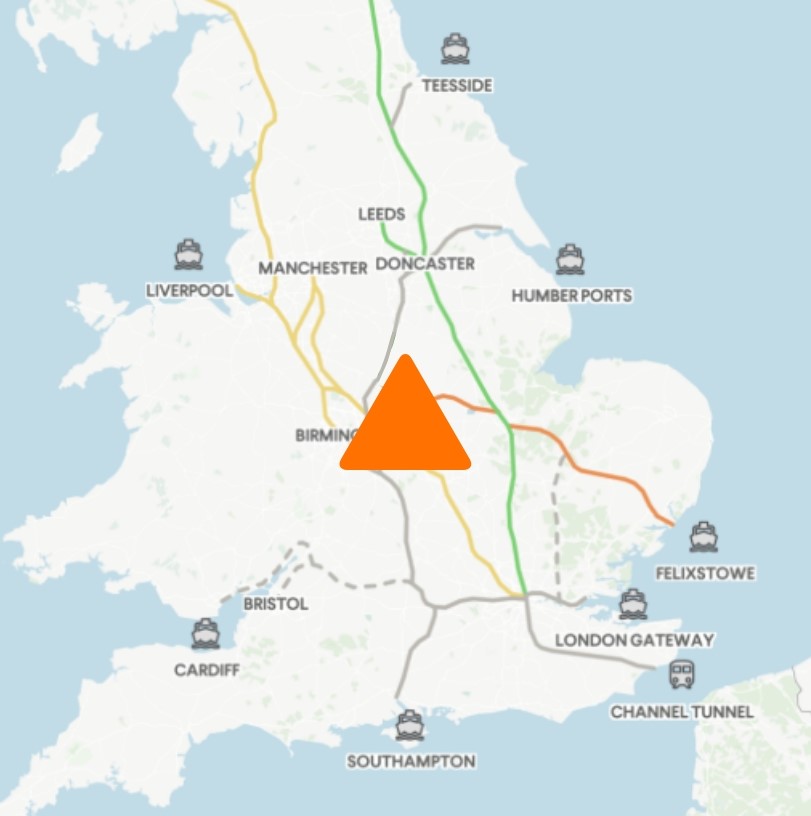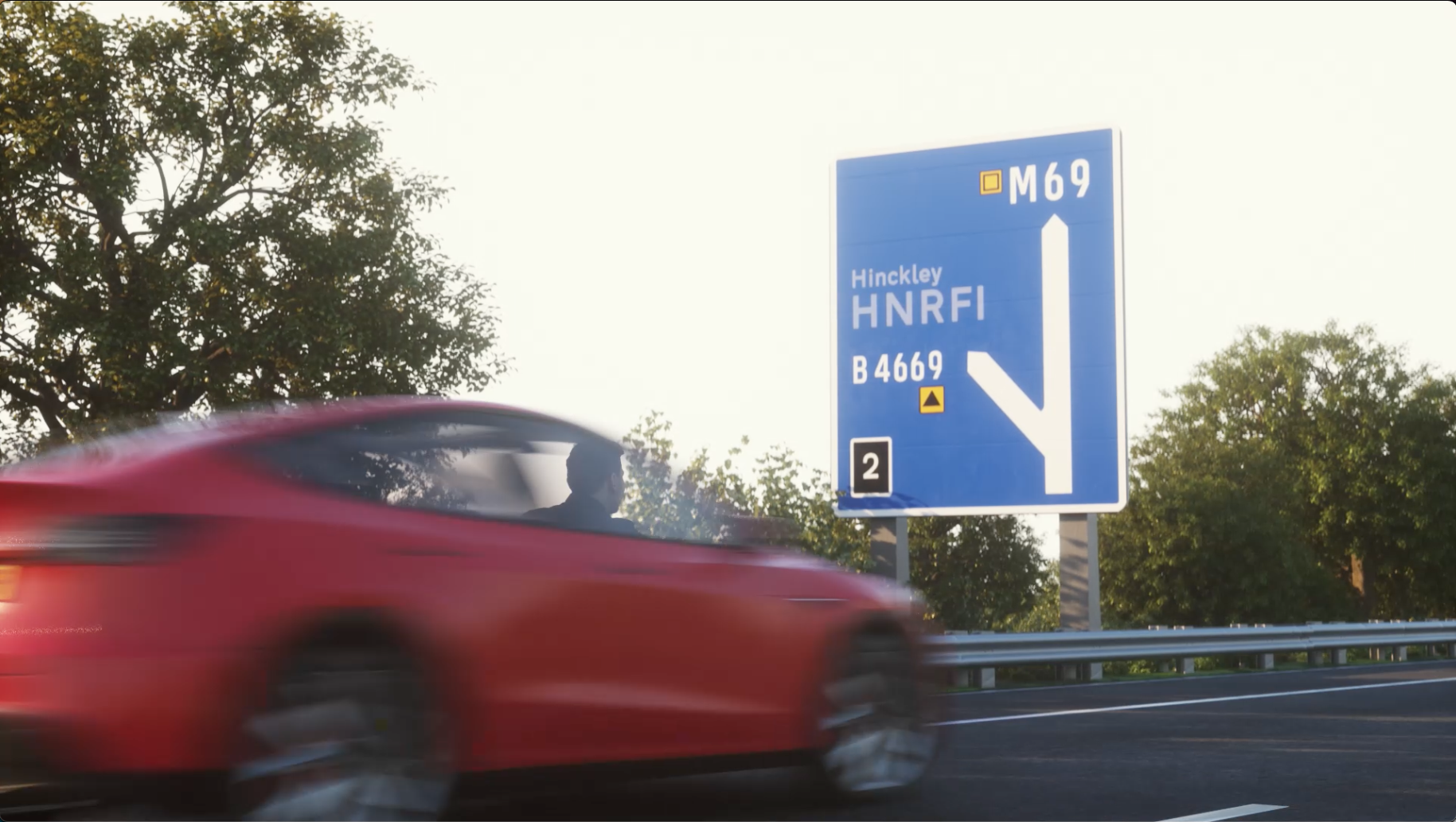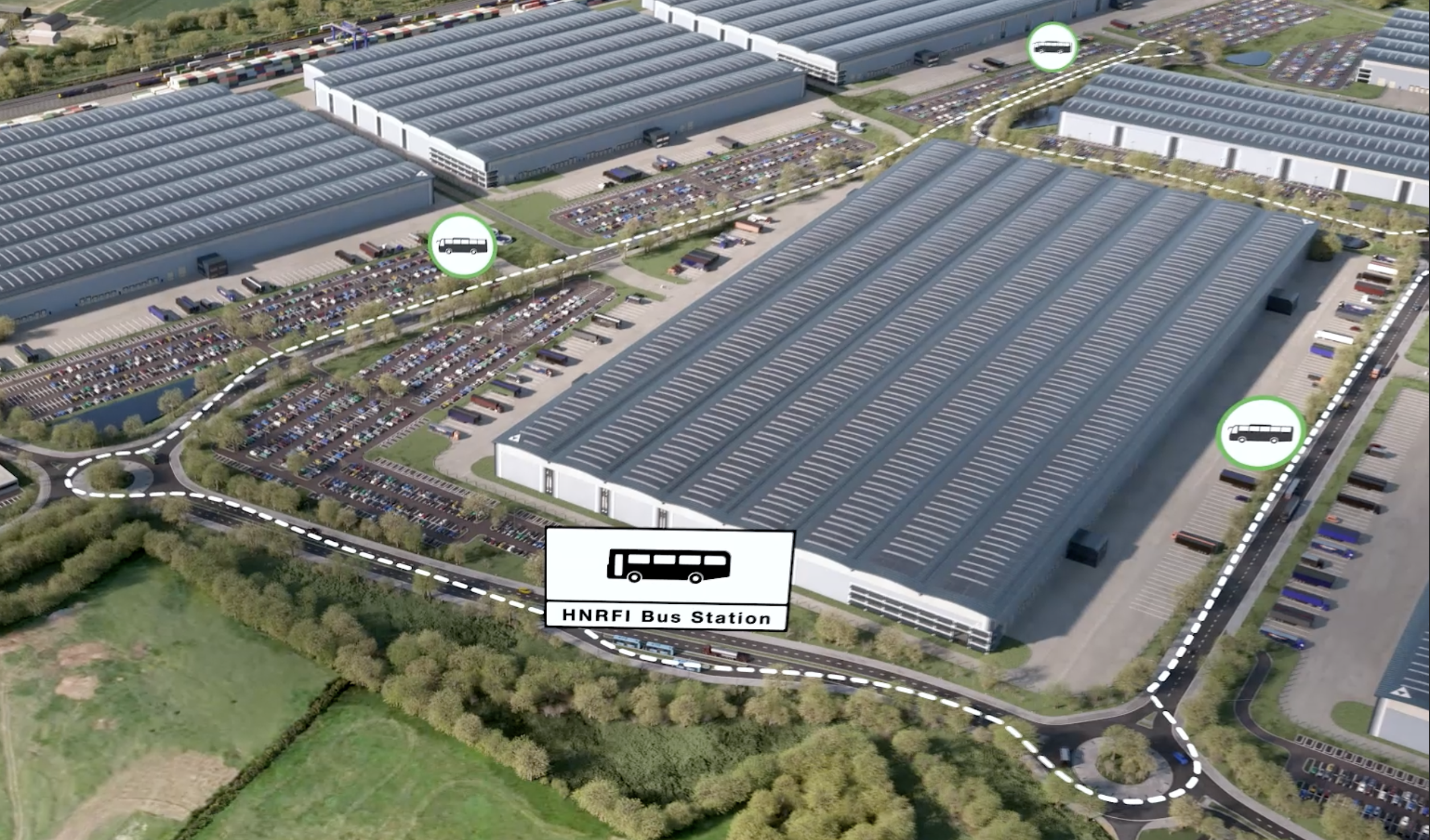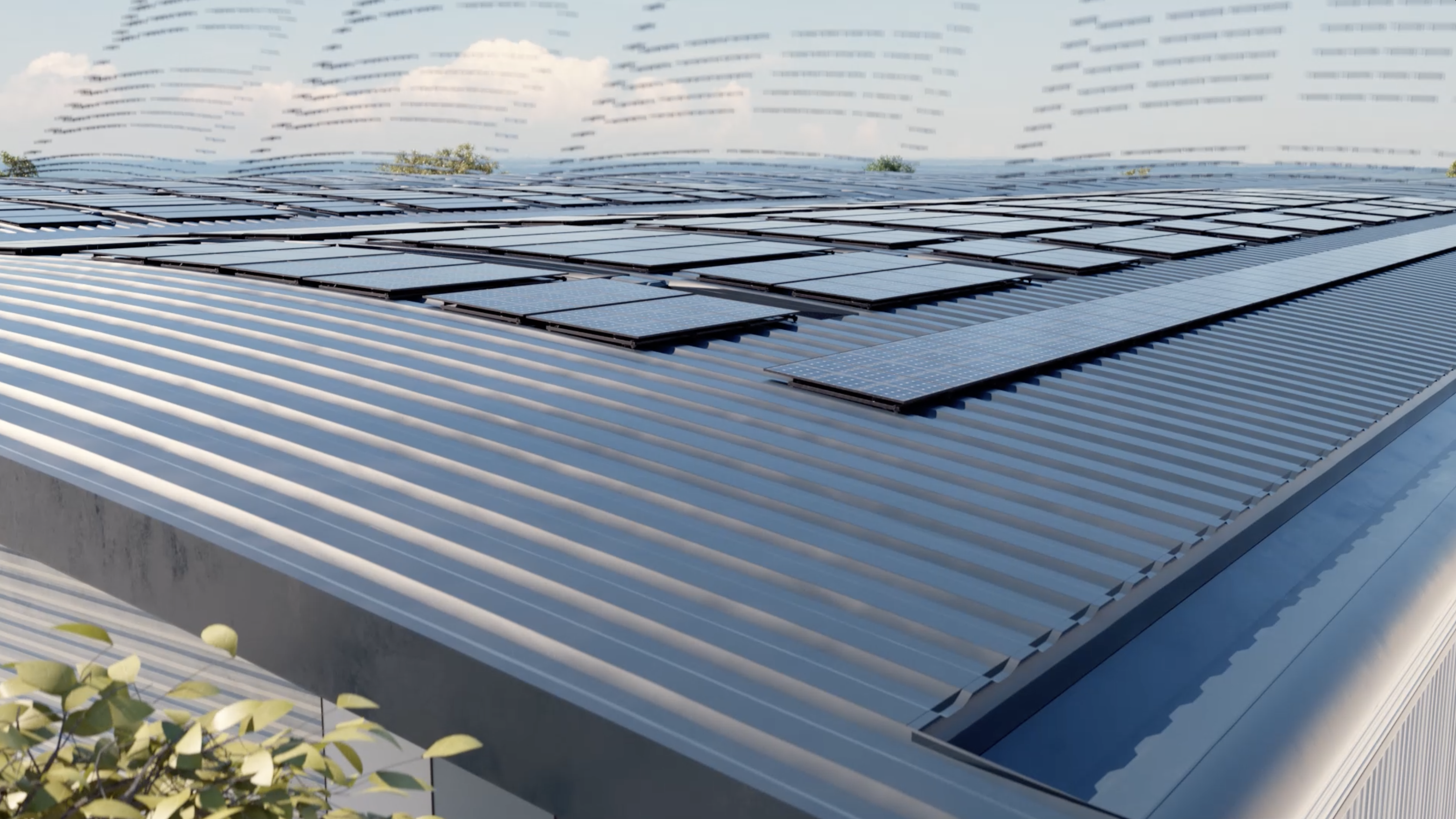Our Development Consent Order (DCO) was accepted for examination on 13th April 2023.
The DCO will move through the subsequent stages and more information can be found on the Planning Inspectorate’s website here.
National Rail Freight Interchange



 Hinckley RFI Site Location
Hinckley RFI Site Location
 Hinckley RFI Site Location
Hinckley RFI Site Location

Our Development Consent Order (DCO) was accepted for examination on 13th April 2023. The DCO will move through the subsequent stages and more information can be found on the Planning Inspectorate's website here.
We have submitted proposals for a rail freight interchange and distribution hub between the Leicester-to-Hinckley railway to the north-west, and the M69 motorway to the south-east. It will be one of the most important infrastructure projects for the region’s connectivity.
Not just a new rail freight interchange, but new roads and transport connections to link up the towns and villages to help reduce congestion in Hinckley and the surrounding area. No other rail freight terminals are connected to this line currently.
We hope to make a once-in-a-lifetime investment of over £750 million of private investment to help Leicestershire thrive by delivering thousands of local jobs with many more sustained through the supply chain, new roads and transport connections to link up the towns and villages that surround the area, and a cleaner, greener environment across the region and the country by removing lorries off the roads.


Hinckley National Rail Freight Interchange will bring people and places closer together with additional slip roads at J2 of M69 and a new 2km link road connecting to the B4468 and onto the A47, helping reduce congestion in central Hinckley and improve connections to Barwell, Earl Shilton and beyond.

Running up to 16 freight trains a day will mean a huge switch from road to rail. Each one will remove up to 76 lorries from our roads.

Creating a new 50 acre green park we’re proposing calling ‘Bridge Farm Parkland’, filled with over 20,000 newly planted trees, providing new habitats for wildlife and with a network of paths and bridleways that connect to Burbage Common.

Hinckley National Rail Freight Interchange could unlock over 8,400 jobs for local people, and brand-new apprenticeships, driving growth and investment in skills for the region’s young people.

Over the past few years, we’ve undertaken three rounds of consultation, issued thousands of letters to local communities, held multiple face-to-face meetings and spoken with businesses, politicians and vulnerable groups. As a result, we’ve amended the plans, and will continue ensuring that the voices of local residents are heard.
The DCO will move through the subsequent stages and more information can be found on the Planning Inspectorate’s website here.
The submitted proposals include:

Over £70 million allocated to improving local infrastructure to alleviate and ease congestion including:

Creation of a new 50-acre park we’re proposing calling ‘Bridge Farm Parkland’ covered with over 20,000 newly planted trees and habitats for wildlife, which connects directly with Burbage Common through a network of paths and bridleways

An extension to the X6 bus route that connects the site to Leicester and Coventry via several stops across the site

A new rail freight terminal and rail infrastructure which can accommodate up to 16 trains a day: a significant volume of goods switched from road to rail meaning saving around 70,120 CO2e each year

State-of-the-art logistics buildings, with lorry park and yards to store imported containers from the trains. The buildings will be carbon net zero in construction, with solar panels that can generate over 40 megawatts of electricity enough to help power the entire site
DCO Application Submission and Acceptance and Stages
Our application for a Development Consent Order (DCO) for the Hinckley National Rail Freight Interchange was accepted on 13th April 2023. The Planning Inspectorate now has approximately three months to prepare for the Examination.
Pre-Examination
At this stage, the public will be able to register with the Planning Inspectorate to become an Interested Party by making a Relevant Representation. An Examining Authority is also appointed at this stage and all Interested Parties will be invited to attend a Preliminary Meeting run and chaired by the Examining Authority. This stage usually takes 3 months.
Examination
The Planning Inspectorate has up to 6 months to carry out the examination. During this stage members of the public who have registered by making a Relevant Representation are invited to provide more details of their views in writing.
Recommendation
The Planning Inspectorate must prepare a report on the application to the Secretary of State for Transport, including a recommendation, within three months of the close of the 6-month Examination Stage.
Decision
The relevant Secretary of State then has 3 months to make the decision on whether to grant or refuse the development consent.
Over the past few years, we’ve undertaken three rounds of consultation, issued thousands of letters to local communities, held multiple face-to-face meetings and spoken with businesses, politicians and community groups.
As a result, we’ve amended the plans, and will continue speaking with local people to raise awareness of our proposals and to work together to address concerns.
We’re committed to investing in Leicestershire, investing in our future, and investing in our environment. We’re not here for the short-haul, but the long-term, and we’re confident our project will deliver great opportunities for local communities, with jobs and skills, improved roads, and cleaner air across the region.
Below is more information on the consultation we have undertaken and important documents we showed to the public as part of our engagement. If you’d like to speak to the project team or have any questions, please contact us here.
22nd Oct – 7th Dec 2018
1. Informal consultation
We undertook a first round of informal pre-application consultation in late 2018, both with statutory consultees, political representatives, community groups, persons with interest in the land, and the community within a zone approximately 3km around the proposed site boundary. The consultation was promoted with direct mail, site notices, public notices, press releases, and social media advertisements.
The consultation comprised eight public exhibitions at venues accessible to the local communities with a range of dates and times. Attendees could submit their feedback via a questionnaire on the website, a paper questionnaire at the public exhibition, via a Community Information Phone Line, dedicated email address, or via post.
8th July - 6th Sept 2019
2. Informal Highways Consultation
A second informal consultation exercise was undertaken in 2019, focussing on potential road effects on local towns and villages, both from the HNRFI development and from the addition of the south-facing slips at Junction 2 of the M69. We explored options to address community concerns about highway impacts through various highway mitigation options.
We promoted the consultation via press releases, direct mail, site notices, public notices and social media advertisements. A total of six public exhibitions were held at various dates, times and venues to maximise public participation. Attendees could submit their feedback via a questionnaire on the website, a paper questionnaire at the public exhibition, via a Community Information Phone Line, a dedicated email address, or via post.
12th Jan – 8th April 2022
3. Formal Consultation
We concluded our formal statutory consultation where we presented our revised proposals to the public and stakeholders. We then entered a process of reviewing all the feedback we received to enabling us to finalise our proposal prior to the submission of our application for a Development Consent Order.
Tritax Symmetry hosted two webinars during the consultation


1.1 Hinckley NRFI DCO Application Letter
Download1.2 Hinckley NRFI DCO Application Form
Download1.3 Hinckley NRFI Section 55 Checklist
Download1.4 Hinckley NRFI Guide to the Application
Download1.5 Hinckley NRFI Electronic Application Index
Download1.6 Hinckley NRFI Signposting for Resubmission
Download2.1 Hinckley NRFI Site Location Plan
Download2.2 Hinckley NRFI Works Plans Key Plan
Download2.2A Hinckley NRFI Works Plans [sheet 1 of 8]
Download2.2B Hinckley NRFI Works Plans [sheet 2 of 8]
Download2.2C Hinckley NRFI Works Plans [sheet 3 of 8]
Download2.2D Hinckley NRFI Works Plans [sheet 4 of 8]
Download2.2E Hinckley NRFI Works Plans [sheet 5 of 8]
Download2.2F Hinckley NRFI Works Plans [sheet 6 of 8]
Download2.2G Hinckley NRFI Works Plans [sheet 7 of 8]
Download2.2H Hinckley NRFI Works Plans [sheet 8 of 8]
Download2.3 Hinckley NRFI Access and Rights of Way Key Plan
Download2.3A Hinckley NRFI Access and Rights of Way [sheet 1 of 4]
Download2.3B Hinckley NRFI Access and Rights of Way [sheet 2 of 4]
Download2.3C Hinckley NRFI Access and Rights of Way [sheet 3 of 4]
Download2.3D Hinckley NRFI Access and Rights of Way [sheet 4 of 4]
Download2.4 Hinckley NRFI Highway Plans Key Plan
Download2.4A Hinckley NRFI Highway Plans [sheet 1 of 8]
Download2.4B Hinckley NRFI Highway Plans [sheet 2 of 8]
Download2.4C Hinckley NRFI Highway Plans [sheet 3 of 8]
Download2.4D Hinckley NRFI Highway Plans [sheet 4 of 8]
Download2.4E Hinckley NRFI Highway Plans [sheet 5 of 8]
Download2.4F Hinckley NRFI Highway Plans [sheet 6 of 8]
Download2.4G Hinckley NRFI Highway Plans [sheet 7 of 8]
Download2.4H Hinckley NRFI Highway Plans [sheet 8 of 8]
Download2.4J Hinckley NRFI Highway Plans Long Sections [sheet 1 of 2]
Download2.4K Hinckley NRFI Highway Plans Long Sections [sheet 2 of 2]
Download2.5 Hinckley NRFI Highway Classification Key Plan
Download2.5A Hinckley NRFI Highway Classification Plans [sheet 1 of 3]
Download2.5B Hinckley NRFI Highway Classification Plans [sheet 2 of 3]
Download2.5C Hinckley NRFI Highway Classification Plans [sheet 3 of 3]
Download2.6 Hinckley NRFI Traffic Regulations Key Plan
Download2.6A Hinckley NRFI Traffic Regulations [sheet 1 of 2]
Download2.6B Hinckley NRFI Traffic Regulations [sheet 2 of 2]
Download2.7 Hinckley NRFI Speed Limit Key Plan
Download2.7A Hinckley NRFI Speed Limit Plans [sheet 1 of 3]
Download2.7B Hinckley NRFI Speed Limit Plans [sheet 2 of 3]
Download2.7C Hinckley NRFI Speed Limit Plans [sheet 3 of 3]
Download2.8 Hinkley NRFI Illustrative Masterplan
Download2.9 Hinckley NRFI Illustrative Context Masterplan
Download2.10 Hinckley NRFI Demolition Plan
Download2.11 Hinckley NRFI Existing Utilities - Features & Areas of Influence
Download2.12 Hinckley NRFI Parameters Plan
Download2.15 Hinckley NRFI Illustrative Sections Through Railway Head Shunt
Download2.16 Hinckley NRFI Illustrative Site Sections [sheet 1 of 2]
Download2.17 Hinckley NRFI Illustrative Site Sections [sheet 2 of 2]
Download2.18.1 Hinckley NRFI Illustrative Phasing and Works Plan 1
Download2.18.2 Hinckley NRFI Illustrative Phasing and Works Plan 2
Download2.18.3 Hinckley NRFI Illustrative Phasing and Works Plan 3
Download2.18.4 Hinckley NRFI Illustrative Phasing and Works Plan 4
Download2.18.5 Hinckley NRFI Illustrative Phasing and Works Plan 5
Download2.18.6 Hinckley NRFI Illustrative Phasing and Works Plan 6
Download2.19 Hinckley NRFI Bridge Plan
Download2.20 Hinckley NRFI Land Plan Key Plan
Download2.20A Hinckley NRFI Land Plan [sheet 1 of 8]
Download2.20B Hinckley NRFI Land Plan [sheet 2 of 8]
Download2.20C Hinckley NRFI Land Plan [sheet 3 of 8]
Download2.20D Hinckley NRFI Land Plan [sheet 4 of 8]
Download2.20E Hinckley NRFI Land Plan [sheet 5 of 8]
Download2.20F Hinckley NRFI Land Plan [sheet 6 of 8]
Download2.20G Hinckley NRFI Land Plan [sheet 7 of 8]
Download2.20H Hinckley NRFI Land Plan [sheet 8 of 8]
Download2.21 Hinckley NRFI Illustrative Sections Through Railport
Download2.22 Hinckley NRFI Illustrative Railport Line Diagram
Download2.23.1 Hinckley NRFI Illustrative Railport Sections Full Scheme Cross Section
Download2.23.2 Hinckley NRFI Illustrative Railport Sections Long Section
Download2.24 Hinckley NRFI Illustrative Rail Connection Options
Download2.25.1 Hinckley NRFI Illustrative Railport General Arrangement Key Plan
Download2.25.2 Hinckley NRFI Illustrative Railport General Arrangement [sheet 1 of 3]
Download2.25.3 Hinckley NRFI Illustrative Railport General Arrangement [sheet 2 of 3]
Download2.25.4 Hinckley NRFI Illustrative Railport General Arrangement [sheet 3 of 3]
Download2.26 Hinckley NRFI Crown Land Key Plan
Download2.26A Hinckley NRFI Crown Land Plan [sheet 1 of 8] v8
Download2.26B Hinckley NRFI Crown Land Plan [sheet 2 of 8]
Download2.26C Hinckley NRFI Crown Land Plan [sheet 3 of 8]
Download2.26D Hinckley NRFI Crown Land Plan [sheet 4 of 8]
Download2.26E Hinckley NRFI Crown Land Plan [sheet 5 of 8]
Download2.26F Hinckley NRFI Crown Land Plan [sheet 6 of 8]
Download2.26G Hinckley NRFI Crown Land Plan [sheet 7 of 8]
Download2.26H Hinckley NRFI Crown Land Plan [sheet 8 of 8]
Download2.27 Hinckley NRFI Order Limits Plan
Download5.1 Hinckley NRFI Consultation Report [Part 1 of 17]
Download5.1 Hinckley NRFI Consultation Report [Part 3 of 17] Appendix 5.1-5.5
Download5.1 Hinckley NRFI Consultation Report [Part 9 of 17] Appendix 6.7-6.12
Download5.1 Hinckley NRFI Consultation Report [Part 13 of 17] Appendix 9.1-9.10
Download5.1 Hinckley NRFI Consultation Report [Part 6 of 17] Appendix 5.7-5.14
Download5.1 Hinckley NRFI Consultation Report [Part 15 of 17] Appendix 9.12 (1)
Download5.1 Hinckley NRFI Consultation Report [Part 14 of 17] Appendix 9.11
Download5.1 Hinckley NRFI Consultation Report [Part 10 of 17] Appendix 7.1-7.7
Download5.2 Hinckley NRFI Other Consents and Licences Report
Download5.1 Hinckley NRFI Consultation Report [Part 5 of 17] Appendix 5.6 (part 2 of 2)
Download5.1 Hinckley NRFI Consultation Report [Part 12 of 17] Appendix 8.10-8.15
Download5.1 Hinckley NRFI Consultation Report [Part 7 of 17] Appendix 6.1-6.6 (part 1 of 2)
Download5.1 Hinckley NRFI Consultation Report [Part 11 of 17] Appendix 8.1-8.9
Download5.1 Hinckley NRFI Consultation Report [Part 16 of 17] Appendix 10.1-10.2
Download5.1 Hinckley NRFI Consultation Report [Part 2 of 17] Appendix 2.1-4.4
Download5.1 Hinckley NRFI Consultation Report [Part 4 of 17] Appendix 5.6 (part 1 of 2)Appendix 5.6 (part 1 of 2) (1)
Download5.1 Hinckley NRFI Consultation Report [Part 8 of 17] Appendix 6.6 (part 2 of 2)
Download5.1 Hinckley NRFI Consultation Report [Part 17 of 17] Appendix 12.1-12.4
Download6.1.2 Hinckley NRFI ES Chapter 2 Site description
Download6.1.1 Hinckley NRFI ES Chapter 1 Introduction
Download6.1.0 Hinckley NRFI ES Chapter 00 Contents and glossary
Download6.1.6 Hinckley NRFI ES Chapter 6 EIA scope and general methodology
Download6.1.5 Hinckley NRFI ES Chapter 5 Relevant legislation and policy
Download6.1.9 Hinckley NRFI ES Chapter 9 Air Quality
Download6.1.3 Hinckley NRFI ES Chapter 3 Project description
Download6.1.8 Hinckley NRFI ES Chapter 8 Transport and Traffic
Download6.1.11 Hinckley NRFI ES Chapter 11 Landscape and Visual Effects
Download6.1.10 Hinckley NRFI ES Chapter 10 Noise and Vibration
Download6.1.7 Hinckley NRFI ES Chapter 7 Land Use and Socio-Economic Effects
Download6.1.12 Hinckley NRFI ES Chapter 12 Ecology and Biodiversity
Download6.1.13 Hinckley NRFI ES Chapter 13 Cultural Heritage
Download6.1.14 Hinckley NRFI ES Chapter 14 Surface Water and Flood Risk
Download6.1.15 Hinckley NRFI ES Chapter 15 Hydrogeology
Download6.1.16 Hinckley NRFI ES Chapter 16 Geology Soils and Contamination
Download6.1.4 Hinckley NRFI ES Chapter 4 Site selection and evolution
Download6.1.17 Hinckley NRFI ES Chapter 17 Materials and Waste
Download6.1.18 Hinckley NRFI ES Chapter 18 Energy and Climate Change
Download6.1.19 Hinckley NRFI ES Chapter 19 Accidents and disasters
Download6.1.20 Hinckley NRFI ES Chapter 20 Cumulative and in-combination effects
Download6.1.21 Hinckley NRFI ES Chapter 21 Conclusion
Download6.4 Hinckley NRFI Non-Technical Summary
Download8.1 Hinckley NRFI Design and Access Statement
Download9.1 Hinckley NRFI DCO Obligation
Download10.1 Hinckley NRFI S.106 Planning Obligation Heads of Terms
Download11.1 The Leicestershire County Council (B4668 Leicester Road Hinckley) (Imposition of 30mph 40mph and 50mph Speed Limits) Order 2008
Download12.1 Hinckley NRFI Pre Water Framework Directive Assmt
Download13.1 Hinckley NRFI Design Code
Download14.1 Hinckley NRFI Statutory Nuisance Statement V3
Download15.1 Hinckley NRFI Statement of Common Ground Intent Schedule
Download17.1 Hinckley NRFI Construction Environmental Management Plan (CEMP)
Download17.2 Hinckley NRFI Landscape Ecological Management Plan (LEMP)
Download17.3 Hinckley NRFI Site Waste and Materials Management Plan (SWMMP)
Download17.4 Hinckley NRFI HGV Management Plan and Route Strategy
Download17.5 Hinckley NRFI Ecological Mitigation and Management Plan (EMMP)
Download17.6 Hinckley NRFI Construction Traffic Management Plan
DownloadHNRFI Energy and Waste Topic Paper
DownloadHNRFI Cultural Heritage Topic Paper
DownloadHNRFI Ecology and Biodiversity Topic Paper
Downloaddb symmetry Community Explanation Document (download)
DownloadHNRFI Geology and Hydrology Topic Paper
DownloadHNRFI Air Quality Topic Paper
DownloadHNRFI Landscape and Visual Effects Topic Paper
DownloadHNRFI Ecological Designations
DownloadHNRFI Policy and Need Topic Paper
DownloadHNRFI Public Rights of Way Topic Paper
DownloadHNRFI Noise and Vibration Topic Paper
DownloadDB-Symmetry-Boards-A1-Parameters-Plan
DownloadHNRFI Land Use and Socio-economic Effects Topic Paper
DownloadHNRFI Rail Freight Topic Paper
DownloadHNRFI Habitat Plan
DownloadDB Symmetry Boards A1 (Masterplan)
DownloadHNRFI Soils and Agricultural Land Quality Topic Paper
Download2018 - Exhibition Boards
DownloadHNRFI Surface Water and Flood Risk Topic Paper
DownloadHNRFI Site Selection Topic Paper
DownloadHNRFI Transport Topic Paper
DownloadTR050007-000024-HRFI-Late-Response-Harborough-District-Council
DownloadTR050007-000010-HRFI - Scoping Report
DownloadTR050007-000023-HRFI - Scoping Opinion
DownloadStatement of Community Consultation
DownloadHNRFI-Statement-of-Community-Consultation
DownloadHNRFI-Draft DCO for Statutory Consultation
DownloadCommunity Explanation Document
DownloadDraft Rail Report
DownloadPlanning Statement (1)
Download39974_Tritax_Hinckley_CommunityInformationLeaflet_AW3_singles_LR3
DownloadExhibition Boards
DownloadHRF-BWB-LSI-XX-DR-CH-00001_Document-2.12_Location-Plan-S3-P03 (1)
DownloadTR050007-000055-HRFI - Scoping Opinion
Download5905 Design and Access Statement - Draft for Consultation - January 2022
DownloadVolume 2 - PEIR Report
DownloadVolume 1 - Non Technical Summary.pdf - UPDATED
DownloadTR050007-000062-HRFI - Scoping Report
DownloadSome types of development are considered by the Government to be Nationally Significant Infrastructure Projects (NSIPs).
Permission for these projects is granted directly by the Government instead of Local Authorities. Strategic Rail Freight Interchanges are NSIPs, so Tritax Symmetry has made its application to the Government, with Local Authorities playing an important consultative role.
A Development Consent Order (DCO) is a special type of planning permission for developments categorised as NSIPs.
A DCO gives a developer the powers it needs to acquire land for and to construct and operate the development. After extensive public consultation, applications for a DCO are submitted to the Planning Inspectorate, which examines the proposals on behalf of the Government and reports to the relevant Government Minister – in this case the Secretary of State for Transport – who will then decide whether to grant a DCO. Further information about the process can be found at: https://infrastructure.planninginspectorate.gov.uk
A Strategic Rail Freight Interchange (SRFI) is often referred to as an ‘in-land port’ due to its ability to successfully transfer freight from road to rail and from suppliers to retailers to consumers.
Government policy dictates that SRFIs are important because they can provide a range of transport, environmental, and economic benefits, and as a result the national policy is that there should be a network of them in the UK. The Government’s National Policy Statement relating to ‘national networks’ published in December 2014, which includes policy guidance on SRFIs, can be found <a href="https://www.gov.uk/government/publications/national-policy-statement-for-national-networks" target="_blank" rel="noopener">here</a>.
More information about the various stages of the national infrastructure planning process can be found on the Planning Inspectorate’s website <a href="https://infrastructure.planninginspectorate.gov.uk/application-process/the-process/" target="_blank" rel="noopener">here</a>. You can read more about Tritax Symmetry's plans <span style="font-weight: 400;">on the Planning Inspectorate website <a href="https://infrastructure.planninginspectorate.gov.uk/projects/east-midlands/hinckley-national-rail-freight-interchange/" target="_blank" rel="noopener">here</a>.</span>
The formal statutory consultation is now closed - thank you to everyone who submitted responses during the consultation period. It ran between Wednesday 12th January and Friday 8th April 2022 (extension from 9th March 2022). You can view the consultation webpage <a href="https://consult.hinckleynrfi.co.uk/" target="_blank" rel="noopener">here.</a>
<span style="font-weight: 400;">You can now submit your feedback via the Planning Inspectorate website <a href="https://infrastructure.planninginspectorate.gov.uk/projects/east-midlands/hinckley-national-rail-freight-interchange/" target="_blank" rel="noopener">here</a>.</span>
Tritax Symmetry will keep its project website up-to-date and post updates to our social media accounts:
<ul>
<li>Facebook – ‘<a href="https://www.facebook.com/HNRFI/" target="_blank" rel="noopener">Hinckley National Rail Freight Interchange – HNRFI</a>’;</li>
<li>Twitter <a href="https://twitter.com/hinckleynrfi" target="_blank" rel="noopener">@hinckleynrfi</a></li>
</ul>
Logistics is the lifeblood which makes the UK’s economy thrive and as our online shopping habits continue to accelerate and our expectations of delivery times increase, the UK logistics industry needs to continue to grow.
The Midlands has long been at the heart of this industry given its location right in the centre of the country. To support and maintain the regional economy, more infrastructure is needed to secure its future
So, the development is needed to create the necessary logistics infrastructure to maximise the ability to use rail freight. This is in accordance with National Policy and the needs of Leicestershire, to secure a sustainable economic future, as set out in the Warehousing and Logistics in Leicester and Leicestershire: <a href="https://www.blaby.gov.uk/media/sxtdil4n/warehousing-and-logistics-in-leicester-and-leicestershire-managing-growth-and-change-study.pdf" target="_blank" rel="noopener">Managing Growth and Change</a>
The scheme includes proposals which could create a logistics hub ideally linked to the major UK container ports. This hub could typically serve engineering industries’ products and parts, as well as warehousing slower moving consumer products and seasonal stock builds.
A private sector investment of over £750 million will be made to deliver the scheme. The development will be funded by Tritax Big Box REIT plc, a FTSE 250 Real Estate Investment Trust specialising in logistics.
The scheme is proposed between the Leicester-to-Hinckley railway to the north-west, and the M69 motorway to the south-east. Most importantly, the site provides access to the Felixstowe to Nuneaton main line. This line connects to a number of other important locations across the country.
If delivered, this would be the only rail freight terminal in the Midlands situated on this line, meaning it will be very connected to the UK’s major ports and provide a huge advantage to the local logistics market. No other sites in the Midlands have enough space to facilitate a new rail freight terminal along this railway.
Potential sites throughout Leicestershire were researched as set out in the Environmental Statement Chapter 4, in line with the LLEP & LCC economic studies for the future of the area. The other sites were not suitable for a range of reasons including HGV access and flood plain issues. SRFI’s are difficult to locate due to the requirement to be able to service up to 775m long trains (to maximise efficiency) and close to the motorway network. Much of the railway infrastructure, mostly developed in the 1800’s, was built in river valleys. HNRFI is not in the Green Belt. HNRFI is close to Warwickshire and will serve parts of the West Midlands as well as Leicestershire in the East Midlands. We did check for alternatives to the west, but the route sits mostly in flood plain and is unsuitable for a SRFI.
At a time when belts are tightening everywhere, we know that investing in local people and creating local opportunities is important. That is why our proposals could deliver over 8,400 jobs for local people, with many more sustained in the supply chain, as well as opportunities for local young people through apprenticeships. This will be supported by over £750 million of private investment into Leicestershire and the wider region, driving growth and opportunities for years to come.
Chapter 7 of the Environmental Statement at figure 7.9 identifies the job types in the Industrial and Logistics sector and the changes that have taken place from 2010 to 2019, there is now a higher share of Professional and Associate Professional and Technical roles, which can be associated with high-skilled engineering and technological professions.
The development will give rise to additional traffic, this has been modelled using a Transport Model issued by the Leicestershire County Highway Authority. However, the scheme could improve travel connections for Leicestershire’s communities with associated highway improvements. It will also include a bus interchange to encourage sustainable travel for new employees as well as electric vehicle charging points.
If consent is secured, it is anticipated that site preparation works, and infrastructure installation will commence from 2025. It is envisaged that the full development may take up to 10 years to complete.
The first warehousing would become operational following the completion of the major infrastructure works that need to be delivered ahead of any warehouses becoming operational.
At the operational stage the site will operate 24 hours per day, seven days per week.
We have engaged with a number of landowners where infrastructure and strategic landscaping may be required for our development. Compulsory purchase will only be sought as a last resort should an appropriate agreement not be reached with those landowners.
Legal letters were sent out by Terraquest, who are our land referencing company, they in effect collect information on land ownerships and land interests which is a requirement of the DCO application process. Many of the legal letters issued by Terraquest related to sub soil interests.
A subsoil interest is a legal presumption that the ground beneath the surface of unregistered public highways is owned by the adjacent freeholders. It could be that your property does not include the land in the highway, but there is often no way of proving this, so we conservatively have to include every freeholder directly adjacent to unregistered public highways in the land referencing exercise.
Land referencing allows us to fulfil our legal duty to identify those persons who may have an interest in the land potentially affected by HNRFI to allow those persons to be consulted directly regarding the proposed development and their comments taken into account and addressed as necessary prior to the submission of the application.
We would like to emphasise that receipt of a letter and Land Interest Questionnaire (LIQ) does not mean that your property or land is directly affected by the scheme. The information from the LIQs is used to ensure those in the area are consulted directly, it does not necessarily mean that your property is required for the scheme.
The proposed highway upgrades at local junctions and on local roads are proposed to be carried out within the adopted highway, we do not intend to Compulsorily Purchase third party land outside of the adopted highway to carry out these upgrades.
Over the past few years, we’ve undertaken three rounds of consultation, issued thousands of letters to local communities, held a number of face-to-face meetings and spoken with and interacted with businesses, politicians and hard-to-reach groups.
We know people were concerned about traffic and transport, the crossing times for local rail junctions, air quality, and the environmental impact on the local area, and that is why we have made a number of changes to the plans to address those concerns.
But residents we speak to are often supportive of the scheme, often once they have received information about its benefits – in particular, that HNRFI could unlock over 8,400 local jobs and brand-new apprenticeships, whilst also driving growth and investment in skills in the area.
At a time when belts are tightening everywhere, we know that investing in local people and creating local opportunities is important. That is why our proposals could deliver over 8,400 jobs for local people, with many more sustained in the supply chain. This will be supported by over £750 million of private investment into Leicestershire and the wider region, driving growth and opportunities for years to come.
HNRFI could also improve connections for Leicestershire’s communities with improvements to J2 of the M69 and a new link road to the A47, improving links between local settlements.
The scheme could also facilitate the removal of 76 lorries from local roads per freight train travelling to HNRFI, supporting the Government’s commitment to Net Zero. Our proposals also include new landscaping and open space where we will plant over 20,000 trees and create new habitats as well as the creation of new publicly accessible green spaces next to Burbage Common with improved foot, cycle and bridle paths across the site.
All of this is being done whilst ensuring that local residents are at the heart of the project through three rounds of consultation, the delivery of letters to local communities, as well as face-to-face meetings and engagement with businesses, politicians and vulnerable groups. As a result, we have had regard to the responses received form consultation and amended the proposals accordingly.
Over the past few years, we have built the voices of local residents into our work and have undertaken three rounds of consultation (two non-statutory & one statutory), in an effort to give as many people as possible the opportunity to give their views.
For our latest consultation, we:
<ul>
<li>Issued letters to 51,000 local residents and businesses</li>
<li>Erected 130 site notices with national and local press notices</li>
<li>Hosted a dedicated online consultation platform</li>
<li>Held nine face-to-face statutory consultation events</li>
<li>Hosted two webinars with Q&As, and posts on social media</li>
<li>Engaged with a wide spectrum of local authorities, local parishes, statutory consultees, local interest groups, hard-to-reach groups, as well as the wider general public all putting forward representations</li>
</ul>
We want to work with local people to deliver our ambitions for HNRFI and will continue doing so in the months ahead.
4,500 HGVs will enter and exit the site over 24 hours. Our worst case scenario, maximum number of HGV movements in a 24 hour period is therefore predicted to be 9,000. This level of trip generation has been agreed with Leicestershire County Council (LCC) and National Highways (NH) (and the other local highway authorities in the Transport Working Group set up by Tritax Symmetry for the purposes of modelling traffic flows created by the development). This is a highly robust figure based on 100% of units assumed to be served by road only with no discounting for HGV movements saved by use of the rail terminal and no discounting for mezzanine floors.
Yes, it is proposed to provide two new slip roads to provide access to/from the M69 south so that it becomes an all ways junction. Indicative highway design plans are available on the consultation website.
Yes, according to the traffic modelling carried out for this consultation, which reflects the worst case scenario for traffic movements. Currently this modelling is being reviewed and re-run, however it is considered that the numbers currently presented are a reasonable estimate. There will be a circa 13% increase in HGV traffic heading northbound in the busiest network peak – light vehicle numbers will be relatively unchanged. Due to the introduction of the new slips at Junction 2 of the M69, allowing southern access, this results in an increase of HGV movements up to 40% towards the south. There is spare capacity within the M69 itself.
There will be some additional traffic heading onto the A47 to head to destinations to the north and west of Leicestershire. High-sided vehicles will be directed onto the A47 to avoid the low bridge on the A5 if heading NW on this route.
Three options were consulted upon in 2019, a bypass around Stoney Stanton, one around Sapcote and the A47 link through the site. The public feedback was very negative to the Stoney Stanton and Sapcote options. Ahead of this consultation we ran three separate scenarios for each of the options through the model.
The A47 link had the most significant benefit in terms of removing traffic from the B581 in Stoney Stanton and providing direct access to the M69 for settlements to the North and West of Hinckley. The Sapcote bypass removed some traffic, but a large number of vehicles were generated by the villages themselves.
The Sapcote Bypass also drew more traffic to it (induced demand) which placed more pressure on the surrounding highway network. There are increases in general traffic through the village, however the numbers are at such a level that they do not justify the construction of a bypass. The proposed mitigation measures within Sapcote and Stoney Stanton are specifically designed to improve safety for residents and to discourage through-routing of vehicles from further afield.
We know that residents are concerned about the impact of further congestion to their local communities, and that’s why we’ve put in place mitigations within the scheme to help address this. A Construction Traffic Management plan has been submitted as part of the proposals and will be secured by a DCO requirement and managed by the contractor on the site. The infrastructure will be constructed within the first phase, including new southern motorway slips at J2 of the M69. The majority of large construction vehicles will be brought into the site via existing slips from the north and directly into the site from the newly formed access. Once the new slips are built, it will allow a greater degree of access from the south for the remainder of the construction.
An HGV routing strategy has been submitted as part of the DCO application and will be secured by a DCO requirement.
There will be a large number of spaces on site for both staff and HGVs. Layover spaces are designed into the individual plots. There is also a 110 space lorry park for users of the site with requisite facilities.
There is a comprehensive strategy that allows connectivity through and around the site, this will comprise a number of diversions and closures as well as the introduction of new routes and enhancements to existing routes. The strategy can be reviewed at appendix 11.2. At Tritax, we understand the importance of green spaces and open areas that families and people can use regularly. That is why we have prioritised protecting local green spaces such as Burbage Common, alongside improved accessibility for everyone through and around the site.
Further traffic modelling has been completed since the consultation and traffic data has been agreed with the Transport Working Group, this is detailed within Chapter 8 of the ES. For the avoidance of doubt, the new traffic modelling outputs do not significantly differ from the previous runs as they feature the same projected development traffic and infrastructure interventions negating the need for further consultation.
The maximum number of intermodal freight trains the site could handle in a day is 16 (32 movements).
The expectation and capacity study undertaken with Network Rail assumes 10 trains (20 movements) to and from the East (Felixstowe, London Gateway and via the East Coast Main Line); and 6 (12 movements) to and from the West (Liverpool, the North West and Scotland via the West Coast Main Line). These would be spread over 24 hours, with a maximum of 2 trains per hour. There would be limited services, if any during the peak hours.
Network Rail have undertaken a detailed analysis of Narborough Station and the barrier down time. Based on the pre-pandemic timetable, in the morning peak hours 7 – 10 am, there is only one possible time an additional intermodal freight train could run. In the afternoon, between 4 – 7 pm only two. Each train would cause a maximum barrier downtime of 2.5mins. This is far less than a stopping passenger train coming from Leicester, which is 4-5 minutes. In each hour the total barrier down time would be approximately 20 minutes, with 40 minutes open which is well within Network Rails acceptable barrier down time at a level crossing.
This line is a key part of Network Rail’s Strategic Freight Network linking Felixstowe to the Midlands and the North. As such the importance of electrifying this line is recognised and will be a priority scheme as part of ongoing investment in this line. New technologies are also being trialled within the rail freight industry, such as hybrid and hydrogen engines.
The scheme will have an operating requirement to turn diesel train engines off within 30 minutes of arrival, so that there can be no long term idling of engines. The terminal is designed so that electric gantry cranes can be utilised to handle containers and the scheme can be used for electric trains using overhead line equipment, if required in the future.
At Tritax, we understand the importance of green spaces and open areas that families and people can use on a daily occasion. That is why we have prioritised protecting local green spaces such as Burbage Common, alongside improved footpaths, cycling paths, and bridleways. We have also amended our scheme already to ensure significant buffer zones and a reduction of building heights to limit impact on local resident’s views of Burbage Common.
No development will take place on Burbage Common / Burbage Woods land, the development site is adjacent to Burbage Common / Burbage Woods and our PROW strategy links in with the existing footpath and bridleway network there.
From an ecological perspective we have looked at the potential impacts on the Burbage Common and Burbage Woods in the form of direct and indirect impacts, air quality, lighting, noise and vibration and recreational impacts. The studies have shown that there is the potential for accidental indirect impacts during construction and the potential for recreational impacts. These will be mitigated through the implementation of non development buffer zones, ecological construction method statements, the provision of additional recreational facilities within the green infrastructure provision and through active management plans. The Environmental Statement Chapter 12 sets out the potential impacts and how these will be mitigated in further detail.
In terms of visual effects, we have taken views within Burbage Common at varying distances from the proposed development of which views towards the Main HNRFI are limited due to intervening mature vegetation and topography within the Common edges of the site. In terms of mitigation a landscape strategy has been produced, of which a bund is proposed along the north-western edge of the railway line and a bund is proposed adjacent to the empty containers yard which will be planted up with woodland species, of which over time will assist in breaking up views and screening lower portions of the proposals. Directly north of Burbage Common Country Park will be a new area of public open space which will be converted from agricultural land to a biodiverse area of similar characteristics to the Country Park. Woodland blocks will also be planted within and in proximity to the western edge of the site which will similarly provide screening of views.
In terms of visual effects upon Burbage Wood, Elmesthorpe Plantation and Aston Firs, views from within these areas to the HNRFI will be limited to its very northern and eastern edges due to their dense wooded nature.
The main HNRFI will be set back from the edges of these areas, incorporating an area of Public Open Space within the western corner of the main HNRFI site as well as providing a green corridor along the southern edge of which a bridleway corridor will be created.
BNG is created by the provision of better quality habitat within the green infrastructure provision than the current habitats present on site, and through the provision of off-site biodiversity creation. Environmental Statement Chapter 12 sets out the current biodiversity impact assessment for the scheme and how the on and off site provision can deliver a 10% net gain. DCO applications currently do not require the delivery of a 10% Biodiversity Net Gain however Tritax Symmetry are proposing to deliver 10% net gain as part of this development.
There will be an inevitable loss of habitats within the site as part of the development proposals and this will impact on certain wildlife species within the site too. However, at Tritax, we understand the importance of green spaces and open areas that families and people can use on a daily occasion. That is why we have prioritised protecting local green spaces such as Burbage Common. We have also amended our scheme already to ensure significant buffer zones and a reduction of building heights to limit impact on local resident’s views of Burbage Common. These are set out within Chapter 12 of the Environmental Statement.
Lighting within the site will have the potential to impact wildlife and therefore buffer zones from development have been incorporated into the scheme around the most sensitive areas. A lighting strategy will be developed that ensures areas of sensitive habitat are maintained within dark corridors and minimum lighting increase levels will be stipulated for these habitats.
Similarly, the lighting strategy will consider the spread of lighting across the wider area in terms of nighttime visual receptors. It is intended that much of the lighting across the site to be kept to a minimum with operational lighting likely to be directional and focused ‘task’ lighting.
A detailed noise model has been generated for the proposed SRFI, to predict the noise impact at nearby properties surrounding the site. The noise model includes noise generating sources such as loading/unloading activities, HGV movements, rail movements, reach stackers, gantry cranes etc. To inform the assessment, the existing noise climate in the vicinity of the properties has been characterised through a long-term baseline noise survey, in line with appropriate guidance, which has been agreed with both Hinckley and Bosworth Borough Council and Blaby District Council, the predicted noise levels generated by the proposed operation of the SRFI has been compared to the existing baseline noise levels to determine the impact. Where an impact has been identified, mitigation has been recommended to reduce the noise levels to within acceptable levels in accordance with the relevant guidance. This includes acoustic barriers of up to 6m in height, and the selection of quiet plant, where appropriate.
We have assessed the impact of the development proposals on air pollutant concentrations in line with appropriate guidance, which has been agreed with both Hinckley and Bosworth Borough Council and Blaby District Council. The change in air quality with the development in operation is negligible in accordance with Institute of Air Quality Management and Environmental Protection UK guidance. Additionally, the air dispersion modelling undertaken predicted pollutant concentrations below the relevant annual mean air quality objectives in the study area with the proposed development in operation.
Whilst the proposed development was not predicted to result in any significant air quality impacts as a result of operational-phase road traffic emissions, mitigation measures are included within the development proposals to minimise emissions associated with the operation of the development. These include provision of Electric Vehicle charging, new footway and cycleways, cycle parking facilities and junction improvements in the vicinity of the site to ease local congestion.
Once HNRFI has been built, each freight train travelling to the interchange could remove 76 lorries from local roads. This will result in 83 million fewer miles travelled by HGVs a year, delivering cleaner air for local communities.

Sinead Turnbull
Planning Director, Tritax Big Box Developments
Sinead.Turnbull@tritaxbigboxdev.co.uk (0)1604 330670
Adam Lloyd
Development Director, Tritax Big Box Developments
Adam.Lloyd@tritaxbigboxdev.co.uk (0)1604 330658
Jake Howard
Associate Development Director, Tritax Big Box Developments
Jake.Howard@tritaxbigboxdev.co.uk (0)1604 330677

